Exfoliation Unclogs Pores by Removing Dead Skin Cells from the Skin Surface

The Essential Info
Healthy skin is constantly undergoing cell turnover. Old skin cells die and flake off, and new cells are born every day.
In acne, this process becomes stalled, with old skin cells getting stuck and accumulating, ultimately clogging pores.
Exfoliation helps to restore normal turnover by removing dead skin cells.
Exfoliation can also help enhance absorption of medications, so exfoliation is included in many anti-acne regimens.
When exfoliating acne-prone skin, the safest way to go is to apply chemical exfoliants, such as glycolic acid or salicylic acid. Physically exfoliating the skin with products like scrubs or treatments like microdermabrasion causes physical irritation, which can lead to more breakouts. Chemical exfoliants do the job of exfoliating without the physical irritation.
The most frequently used over-the-counter chemical exfoliants are:
- Glycolic Acid: Glycolic acid is the most well-known ingredient in topical exfoliating products. It is available in strengths up to 10% over-the-counter.
- Salicylic Acid: Salicylic acid is best known as an anti-acne ingredient. It works by exfoliating and also reducing inflammation. It is available in strengths up to 2% over-the-counter.
Exfoliation on its own is unlikely to clear acne to the degree most people are looking for, but when included within a proper anti-acne regimen, it can turbo-charge results.
Don’t Overdo It: Once you start exfoliating, you’ll notice your skin getting a “glow” to it, with compliments most likely coming your way. This makes it tempting to exfoliate more. But with chemical exfoliants, it’s important not to get carried away with it. If using glycolic acid, use it only once every other day at full strength, or 1/2 and 1/2 with moisturizer once a day. Over-the-counter salicylic acid products are less potent, so you can use them up to twice a day, every day.

The Science
- The Circle of Life in Healthy Skin
- How Skin Turnover Goes Wrong in Acne
- How Exfoliants Benefit Acne-prone Skin
- The Bottom Line
Exfoliation refers to the removal of dead skin cells. This happens naturally when dead skin cells fall off to be replaced by new skin cells in a constant process of turnover. However, in acne-prone skin, this process slows down and pores become clogged. Therefore, products that exfoliate the skin can help.
Products that exfoliate the skin come in two types:
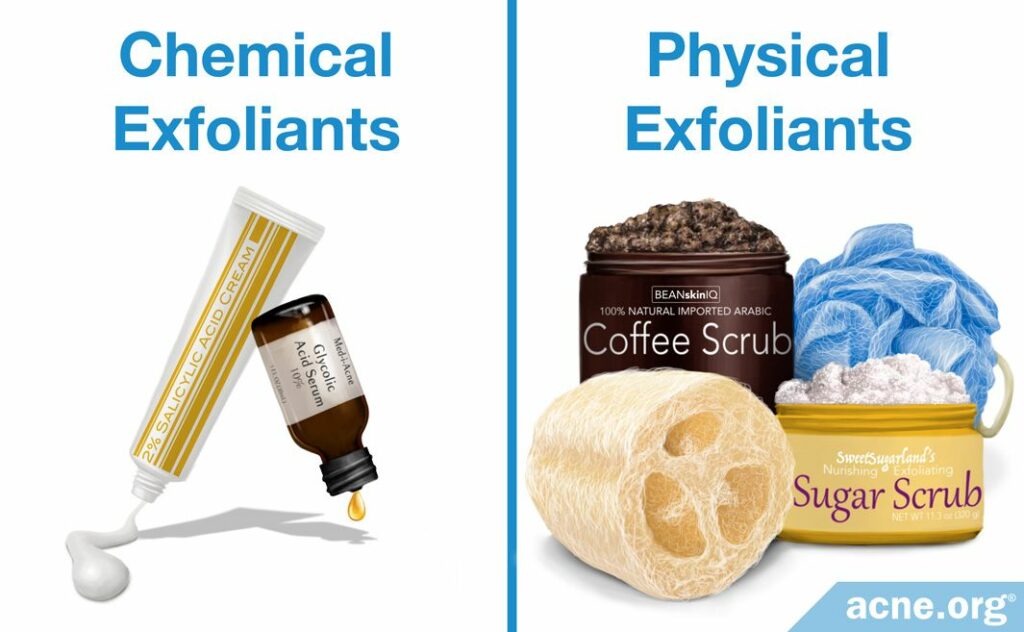
- Chemical exfoliants: These are acids that are applied topically to the skin.
You can purchase over-the-counter products containing these chemicals, such as glycolic acid, in strengths up to 10%, or you can schedule a chemical peel at an esthetician’s or doctor’s office where higher percentage acids can be used.
Chemical exfoliants work by helping to gently break down the connections between dead skin cells so they can flake off easily. This can be beneficial for acne-prone skin by ensuring timely removal of dead skin cells, which would otherwise build up and clog skin pores. Some chemical exfoliants have additional benefits, like decreasing inflammation.
The verdict: Potentially beneficial
- Physical exfoliants: These are objects like loofahs or substances like scrubs containing crystals or rough particles.
Physical exfoliants work by physically rubbing the skin surface, dislodging dead skin cells.
Examples include loofahs, coffee scrubs, and sugar scrubs.
While it seems to make common sense that physical exfoliants can help “scrub away acne,” the opposite is true. Physical exfoliants are likely to do more harm than good to acne-prone skin by physically irritating the skin. It is well known that physical irritation can make acne worse.
The verdict: Avoid
To understand exactly how chemical exfoliants can benefit acne-prone skin, let’s start by taking a look at the normal process of cell turnover in healthy skin and how that process goes wrong in acne.
The Circle of Life in Healthy Skin
The skin is the largest organ of the human body, and, as our external covering, it performs several important functions:
- Protecting the body from the external environment, including injuries, infections, harmful chemicals, and the sun’s rays
- Regulating body temperature
- Preventing dehydration (excessive loss of water from the body)1-3
Because the skin is exposed to the elements, it needs to constantly renew itself in order to be able to do its job. This is why the top layer of the skin, called the epidermis, is constantly producing new skin cells while old cells die and flake off. This process occurs naturally and does not interfere with the skin’s functioning.
Scientists estimate that it takes a human skin cell about 40-56 days to go through the full life cycle from birth to dying and flaking off.4 At any given time, your skin contains cells that were just born, cells that have died and are about to come off, as well as cells at various intermediate stages of the life cycle. Normally, the processes of cell birth and cell death are in balance, so that for every new skin cell that is born, another skin cell dies and is shed.
The circle of life in healthy skin: the full scoop
The upper, most superficial section of the skin is called the epidermis. This is the part of the skin that constantly renews itself.
The epidermis is subdivided into several layers. Skin cells begin their life cycle in the deepest layer, called the stratum basale. As they mature, they make their way up through the layers toward the most superficial layer, called the stratum corneum. Along the way, skin cells gradually lose their organelles (the internal parts that make cells work) and produce more and more keratin, a key protein in the skin. At the end of their life cycle, skin cells become dead shells filled with keratin.1-3
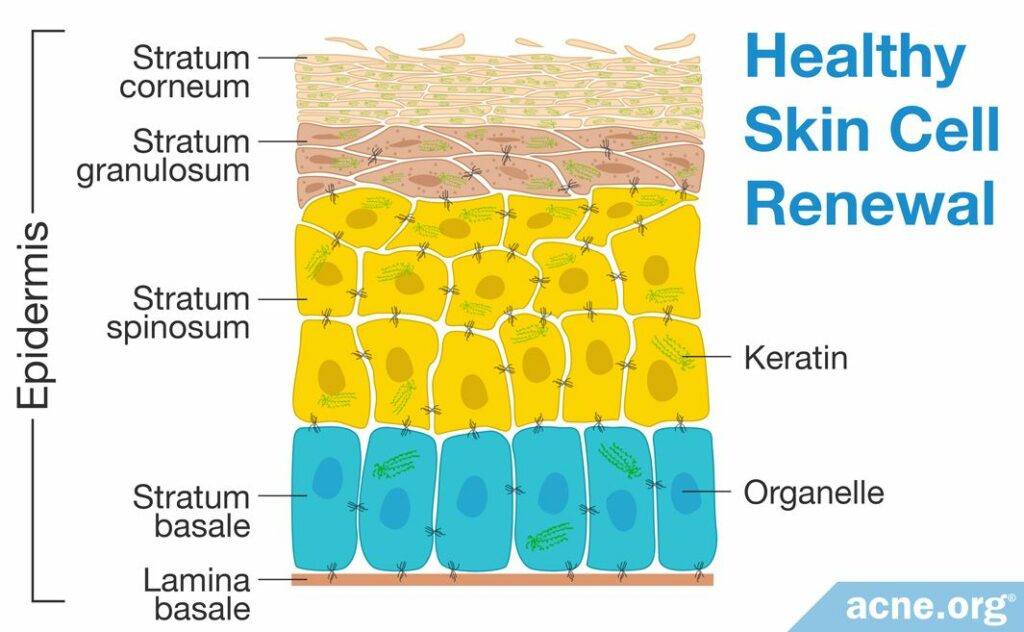
Living skin cells are connected to each other by strong, sticky connections called desmosomes. When skin cells die and the time comes for them to flake off, special enzymes in the skin break down these connections so that the dead skin cells can detach.1-3
How Skin Turnover Goes Wrong in Acne
There are two things that go wrong in acne-prone skin:
- Skin cells divide faster than normal: New cells are born more quickly than dead cells come off.
- Dead skin cells do not come off when they should: Dead cells stay attached to the skin surface and to the inner lining of skin pores.
In other words, the balance between cell birth and cell death and removal is disrupted, so that too many cells are born and too few dead cells are shed. This results in an excess of skin cells. These extra cells end up clogging skin pores like a cork stuck in a bottle.
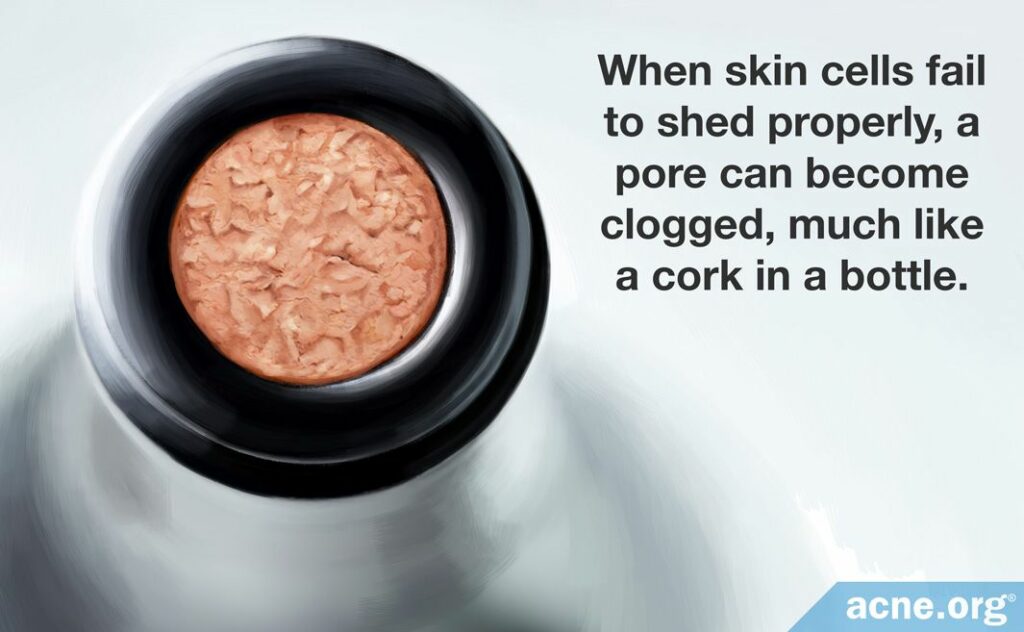
Skin oil builds up in the clogged pore, creating the perfect conditions for acne bacteria to multiply. Once that happens, an inflammatory lesion, or what people usually call a pimple or a zit, that is red and sore, can erupt.5-9
How skin turnover goes wrong in acne: the full scoop
In acne-prone skin, the enzymes which are supposed to break down the desmosomes between dead skin cells do not function as well as in healthy skin. This is the reason why dead skin cells continue to hang around and clog pores instead of flaking off in a timely manner.
This, together with the fact that skin cells are dividing faster than normal, results in what scientists call “retention-proliferation hyperkeratosis,” or, in plain English, too many skin cells.5-9
How Exfoliants Benefit Acne-prone Skin
Studies have shown that chemical exfoliants may:
- Directly help clear acne
- Help other acne treatments work better when used in combination
The most common chemical exfoliants are glycolic acid (an alpha hydroxy acid) or salicylic acid (a beta hydroxy acid). Hydroxy acids work by breaking down connections between dead skin cells so that they can flake off easily from the skin and from inside pores.10
When dead skin cells shed in a timely manner, skin pores can remain clear and skin oil can empty onto the skin surface instead of becoming trapped inside pores. In other words, by removing excess dead skin cells, hydroxy acids keep pores clean and prevent the formation of new clogged pores.10-13 Some scientists also suggest that higher concentrations of hydroxy acids can “unroof” pustules (pimples with a white head on them)–in other words, help clear existing pimples as well.11,12
The removal of dead skin cells also sends a signal into the skin to produce new cells. This helps keep the circle of life chugging along in the skin, constantly getting rid of old cells and replacing them with new ones.
Exfoliation offers additional benefits as well. It:
- Makes the skin look smoother. People sometimes refer to the skin looking more “radiant” or with a “glow.”
- Makes the skin firmer and more elastic by stimulating the production of collagen, a skin protein that helps the skin look youthful.
- Helps with hyperpigmentation (dark/red spots left behind after acne lesions heal).
- Helps increase the penetration of topical acne medications by removing excess dead cells from pores and from the skin surface.
- May improve skin hydration.10,13-15
In addition, some chemical exfoliants, like salicylic acid, can suppress inflammation, which is an integral part of acne.10,13,16
How effective are chemical exfoliants?
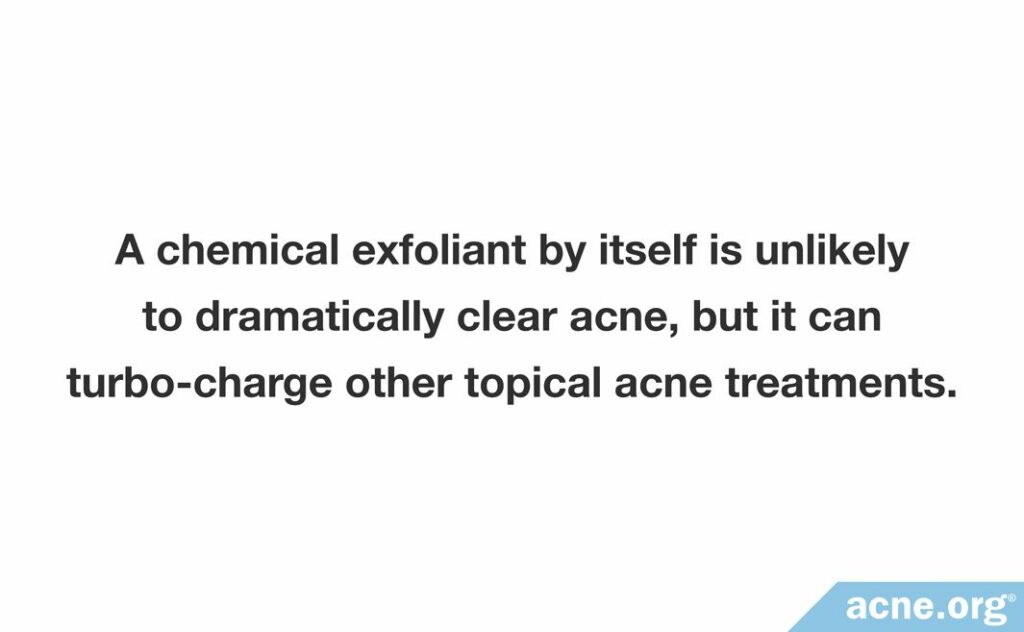
Chemical exfoliants can help with acne but are not recommended as a stand-alone treatment. In other words, just using a chemical exfoliant by itself is unlikely to dramatically clear acne.
The effectiveness of chemical exfoliants depends on their concentration. Lower concentrations like those found in over-the-counter products act on superficial layers of the skin and can help “turbo-charge” other topical acne treatments. Higher-concentration chemical peels that are applied in a doctor’s office or esthetician’s office can work their way deeper into the skin and produce more dramatic results. However, one recent study found that even professional chemical peels only produce results for mild-to-moderate facial acne and have little effect on severe acne.10

According to a 2011 article in the Journal of the European Academy of Dermatology and Venereology, “When used in mild-to-moderate facial acne, superficial peels reduce acne lesions.”10
Recent studies suggest that combinations of chemical peels may produce better results for mild-to-moderate acne than chemical peels that are used individually.17-20 However, we should note that the studies performed so far have been relatively small, so further research is necessary to confirm that the benefits of combining chemical peels outweigh the potential drawbacks.
Expand to read details of studies

The first study was published in the Journal of Cosmetic Dermatology in 2018. The researchers divided 45 patients with mild-to-moderate acne into 3 groups:
- Group A received a combination of Jessner’s solution and TCA peels on the right side of the face and TCA alone on the left side of the face
- Group B received salicylic acid and mandelic acid peels on the right side of the face and salicylic acid alone on the left side of the face
- Group C received Jessner’s solution and TCA peels on the right side of the face and salicylic and mandelic acid peels on the left side of the face
Each patient underwent 6 treatment sessions at 2-week intervals. The researchers evaluated the results 3 months after the last session. They concluded that while in all three groups, both sides of the face showed improvement, acne was most improved on the sides of the face treated with combination peels. The researchers wrote, “Combination sequential peels gave the best results.”18
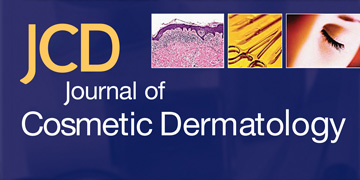
The second study was published in the same journal in 2020. The researchers tested a combination product containing both salicylic acid and glycolic acid on 66 patients with mild-to-moderate acne. The patients used the product every night for 2 weeks. The researchers found that this regimen significantly improved acne by reducing the number of non-inflammatory as well as inflammatory lesions. In addition, 70-80% of the patients reported a resulting decrease in oiliness, improved texture, and smoother-looking skin, which the doctors confirmed upon examination.19

The third study was also published in the same journal in 2021. This study tested a serum containing a combination of 6 different chemical peel ingredients on 42 patients with moderate acne, oily skin, and post-inflammatory hyperpigmentation. The chemical peel ingredients were dioic acid, glycolic acid, salicylic acid, lipohydroxy acid, citric acid, and HEPES (an acronym that stands for N-2-hydroxyethylpiperazine-N’-2-ethanesulfonic acid). The patients used the serum twice a day for 56 days. The researchers found that this treatment regimen decreased acne lesions by 29.4% and also improved post-inflammatory hyperpigmentation. Using the serum also decreased skin oiliness by 30.7% after just 7 days. Thus, researchers concluded that the combination of multiple chemical peel ingredients showed promise in the treatment of acne.20
How exfoliants benefit acne-prone skin: the full scoop

As explained in a 2011 article in the Journal of the European Academy of Dermatology and Venereology, chemical exfoliants like hydroxy acids attack improve dead skin removal in two ways:
- They break down the desmosomes, or tight connections, between dead skin cells
- They increase the activity of enzymes in the skin that are supposed to naturally break down the desmosomes between dead skin cells10
The Bottom Line
In the real world, what all of this means is that adding chemical exfoliation to your anti-acne routine may help reduce acne, help other medications (like benzoyl peroxide) work better, and leave you with a nice “glow” to your skin that people are likely to compliment.
However, don’t overdo it. Use over-the-counter glycolic acid products only once every other day at full strength, or once a day if you mix it 1/2 and 1/2 with a moisturizer. Over-the-counter salicylic acid products are produced at lower strengths, and so they can be used up to twice a day.
References
- Denecker, G., Ovaere, P., Vandenabeele, P. & Declercq, W. Caspase-14 reveals its secrets. J Cell Biol 180, 451 – 458 (2008). https://www.ncbi.nlm.nih.gov/pmc/articles/PMC2234247/
- Eckhart, L., Lippens, S., Tschachler, E. & Declercq, W. Cell death by cornification. Biochem Biophys Acta 1833, 3471 – 3480 (2013). https://www.ncbi.nlm.nih.gov/pubmed/23792051
- Wong, D. J. & Chang, H. Y. Skin tissue engineering. https://www.ncbi.nlm.nih.gov/books/NBK27029/
- Koster, M. I. Making an epidermis. Ann N Y Acad Sci 1170, 7 – 10 (2009). https://www.ncbi.nlm.nih.gov/pubmed/19686098
- Webster, G. F. & Rawlings, A. V. Acne and Its Therapy. (Informa Healthcare USA, Inc., 2007). https://www.crcpress.com/Acne-and-Its-Therapy/Webster-Rawlings/p/book/9780824729714
- Moradi T. S. et al. Acne vulgaris. Nat Rev Dis Primers 1, 15029 (2015). https://www.ncbi.nlm.nih.gov/pubmed/27189872
- Degitz, K., Placzek, M., Borelli, C. & Plewig, G. Pathophysiology of acne. J Dtsch Dermatol Ges 5, 316 – 323 (2007). https://www.ncbi.nlm.nih.gov/pubmed/17376098
- Tosti, A., Grimes, P. E. & De Padova, M. P. (Eds.). Color Atlas of Chemical Peels. (Springer, 2012). https://www.springer.com/gp/book/9783662499825
- Innovation in acne treatment is long overdue but the treatment pipeline looks promising. https://www.pharmaceutical-journal.com/news-and-analysis/features/innovation-in-acne-treatment-is-long-overdue-but-the-treatment-pipeline-looks-promising/20203702.article?firstPass=false
- Dréno, B. et al. Expert opinion: efficacy of superficial chemical peels in active acne management–what can we learn from the literature today? Evidence-based recommendations. J Eur Acad Dermatol Venereol 25, 695 – 704 (2011). https://www.ncbi.nlm.nih.gov/pubmed/21029205
- Araviiskaia, E. & Dréno, B. The role of topical dermocosmetics in acne vulgaris. J Eur Acad Dermatol Venereol 30, 926 – 935 (2016). https://www.ncbi.nlm.nih.gov/pubmed/26916232
- Tung, R. C., Bergfeld, W. F., Vidimos, A. T. & Remzi, B. K. Alpha-Hydroxy acid-based cosmetic procedures. Guidelines for patient management. Am J Clin Dermatol 1, 81 – 88 (2000). https://www.ncbi.nlm.nih.gov/pubmed/11702315
- Kempiak, S. J. & Uebelhoer, N. Superficial chemical peels and microdermabrasion for acne vulgaris. Semin Cutan Med Surg 27, 212 – 220 (2008). https://www.ncbi.nlm.nih.gov/pubmed/18786500
- Rodan, K., Fields, K., Majewski, G. & Falla, T. Skincare Bootcamp: The Evolving Role of Skincare. Plast Reconstr Surg Glob Open 4, e1152 (2016). https://www.ncbi.nlm.nih.gov/pmc/articles/PMC5172479/
- DiNardo, J. C., Grove, G. L. & Moy, L. S. Clinical and histological effects of glycolic acid at different concentrations and pH levels. Dermatol Surg 22, 421 – 424 (1996). https://www.ncbi.nlm.nih.gov/pubmed/8634803
- Kontochristopoulos, G. & Platsidaki, E. Chemical peels in active acne and acne scars. Clin Dermatol 35, 179-182 (2017). https://pubmed.ncbi.nlm.nih.gov/28274356/
- Chilicka, K., Gold, M. H. & Nowicka, D. Acne vulgaris and the most popular and new cosmetological treatments. J Cosmet Dermatol 22, 1946-1950 (2023). https://pubmed.ncbi.nlm.nih.gov/37062752/
- Nofal, E., Nofal, A., Gharib, K., Nasr, M., Abdelshafy, A. & Elsaid E. Combination chemical peels are more effective than single chemical peel in treatment of mild-to-moderate acne vulgaris: A split face comparative clinical trial. J Cosmet Dermatol 17, 802-810 (2018). https://www.ncbi.nlm.nih.gov/pubmed/30203434
- Wiegmann, D. & Haddad, L. Two is better than one: The combined effects of glycolic acid and salicylic acid on acne-related disorders. J Cosmet Dermatol 19, 2349-2351 (2020). https://pubmed.ncbi.nlm.nih.gov/32250551/
- Campos, V., Pitassi, L., Kalil, C., Gonçalves Júnior, J. E., Sant’Anna, B. & Correia, P. Clinical evaluation of the efficacy of a facial serum containing dioic acid, glycolic acid, salicylic acid, LHA, citric acid, and HEPES in treating post-inflammatory hyperchromia and controlling oily skin in patients with acne vulgaris. J Cosmet Dermatol 20, 1766-1773 (2021). https://pubmed.ncbi.nlm.nih.gov/33617668/
The post How Exfoliation Helps with Acne appeared first on Acne.org.
